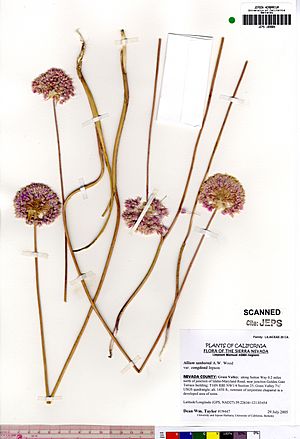Sanborn's onion facts for kids
Quick facts for kids Allium sanbornii |
|
|---|---|
 |
|
| Allium sanbornii var. congdonii | |
| Scientific classification | |
| Synonyms | |
|
Allium sanbornii is a type of wild onion found in North America. It's often called Sanborn's onion. This plant naturally grows in northern California and southwestern Oregon. You can find it in special serpentine soils, which are a unique kind of rocky soil, in the southern Cascade Range and the northern parts of the Sierra Nevada foothills.
About Sanborn's Onion
Sanborn's onion is a fascinating plant that belongs to the same family as the onions you might eat! It's known for its pretty flowers and where it chooses to grow.
What Sanborn's Onion Looks Like
This wild onion grows from a reddish-brown bulb, which is like a small underground storage part, about 2.5 centimeters (1 inch) long. It sends up a tall stem called a scape, which can reach up to 60 centimeters (about 2 feet) tall. This stem has a single, long, round leaf that is usually about the same length as the stem.
At the top of the stem, Sanborn's onion has a cluster of many small flowers, sometimes as many as 150! This flower cluster is shaped like an umbrella and is called an umbel. Each tiny flower has petals, called tepals, that are less than a centimeter long. These tepals can be pink or white, and they often have darker red lines running down the middle. The flowers also have yellow or purple anthers (the parts that hold pollen) and the pollen itself can be yellow or white.
Different Types of Sanborn's Onion
Just like there can be different types of apples, there are also different types, or varieties, of Sanborn's onion. These varieties are slightly different from each other and grow in specific areas.
- Allium sanbornii var. congdonii - This variety is found in areas from Nevada County to Mariposa County in California.
- Allium sanbornii var. sanbornii - This is the main variety. It grows from Shasta County to Mariposa County in California, and also in Jackson and Josephine Counties in Oregon.
Sometimes, plants that were once thought to be a variety of Sanborn's onion are later found to be their own separate species. This is how scientists learn more about plants! For example:
- Allium sanbornii var. jepsonii is now known as Allium jepsonii.
- Allium sanbornii var. tuolumnense is now known as Allium tuolumnense.

